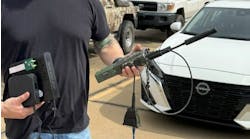Is It Just That Pair, or Is It the Whole Cable?
I received a question from a reader about my December 2009 column, "Outside Plant Fault Locating the Triple Play Service", and thought that some of you other readers may wonder about this. Here you go:
Don,
We appreciate your columns and just finished reading your December 2009 article regarding Triple Play testing.
In your last article you mentioned grounding tip and ring to ground at the remote and testing Longitudinal Balance. And that balance below 60db indicated series (inline) Resistance. I thought LB was more of an LC calculation. Could you explain further?
We always compare ring/tip to ground reading and hope to keep it within 1%. But did not realize LB could be tested to Ground.
My Response
Because we center tap our cable pair for voice grade service, all information travels along tip and ring equally when the pair is balanced. No signal travels across the pair from the tip to the ring or from the ring to the tip. If the pair is unbalanced, signal flows from the tip to the ring or from the ring to the tip across the pair. The difference in signal from the tip to the ring or from the ring to the tip is referred to as metallic or circuit noise. To keep circuit noise at an acceptable level <20dBrnC, the pair must be balanced. This is what longitudinal balance is all about.
In order to have good longitudinal balance there must be good pair balance. Pair balance consists of the capacitance and the linear wire resistive balance tip and ring to ground.
I prefer to measure capacitance in microfarads and then convert it to footage. For example, tip to ground shows .18 microfarads and ring to ground measures .18 microfarads. Then divide .18 by .18 and that equals 1 or 100% capacitive balance. Or, tip to ground measures .16 microfarads and ring to ground measures .18 microfarads then .16 divided by .18 equals .89 or 89%. That pair is open one side on a lateral, open one side on a bridged tap (open beyond the customer’s drop terminal) or crossed with a non working conductor. Good capacitive balance will show greater than 98% balanced.
When there is a marginal or poor capacitive balance, the customer complaint on the voice grade service is, "I have a hum on my line". There is a myriad of complaints on the bandwidth side including slow modem speed, modem dumping, set-top boxes dropping, freezing, pixelization, etc., in the FTTN IPTV business.
To determine linear wire resistive balance, short and ground the cable pair to a 0 ohm ground at the far end. Use your ohmmeter to first measure tip to ring ohms and then tip to ground and ring to ground ohms. Tip and ring to ground should be equal and 1/2 the tip to ring ohms. Any series resistance on a ring or tip conductor that measures as little as 5 ohms will disrupt service.
When there is an unacceptable linear wire resistive balance on the pair the customer complaint on the voice grade service is, "I have static on my line". Again, on the bandwidth side of the house there are countless similar complaints that show up because of poor capacitive balance plus complaints of macro blocking.
A longitudinal balance calculation can be used to identify a marginal or poor balance problem on a circuit but there is a caveat to the calculation. Power Influence (PI) must measure at least 70dBrnC in order to get meaningful information and even then the test can be invalid. First, measure and record PI, then measure and record circuit (metallic) noise. If PI is greater than 70dBrnC, subtract circuit (metallic) noise from PI. If the difference is greater than 60dB, then that pair is balanced. If the difference is less than 60dB, that pair is unbalanced.
The root causes of marginal or unacceptable longitudinal balance are:
• Crossed battery.
• A Tip or Ring ground.
• Open one side on a lateral, open one side on a bridged tap, crossed with a non-working pair.
• Series resistance.
When PI is less than 80dBrnC, many multi-functional test sets have a longitudinal balance test. Using a single frequency in the voice grade range representing PI above 70dBrnC to raise circuit (metallic) noise that noise is subtracted from that PI and then longitudinal balance is calculated. Any measurement greater than 60dB, indicates that pair is balanced. Any measurement less than 60dB, then that pair is unbalanced and the root cause must be identified, located, and repaired.
Now for the caveat: there must be at least 1,000 feet (307 meters) of cable pair capacitance beyond any series resistance or the longitudinal balance test will pass when it should have failed. To prevent this problem, place a grounded short on the far end of the cable pair. If there is series resistance anywhere in any length of cable pair that pair will fail the longitudinal balance test. The root cause (series resistance) can be located and repaired.
Signing Off
I hope this was helpful. I am always impressed by the interest and the types of questions. You can help fellow technicians out by sending in your questions. No question is a bad question — and if you want, send it in anonymously. But please send them! Contact me at [email protected] or 831.818.3930.




